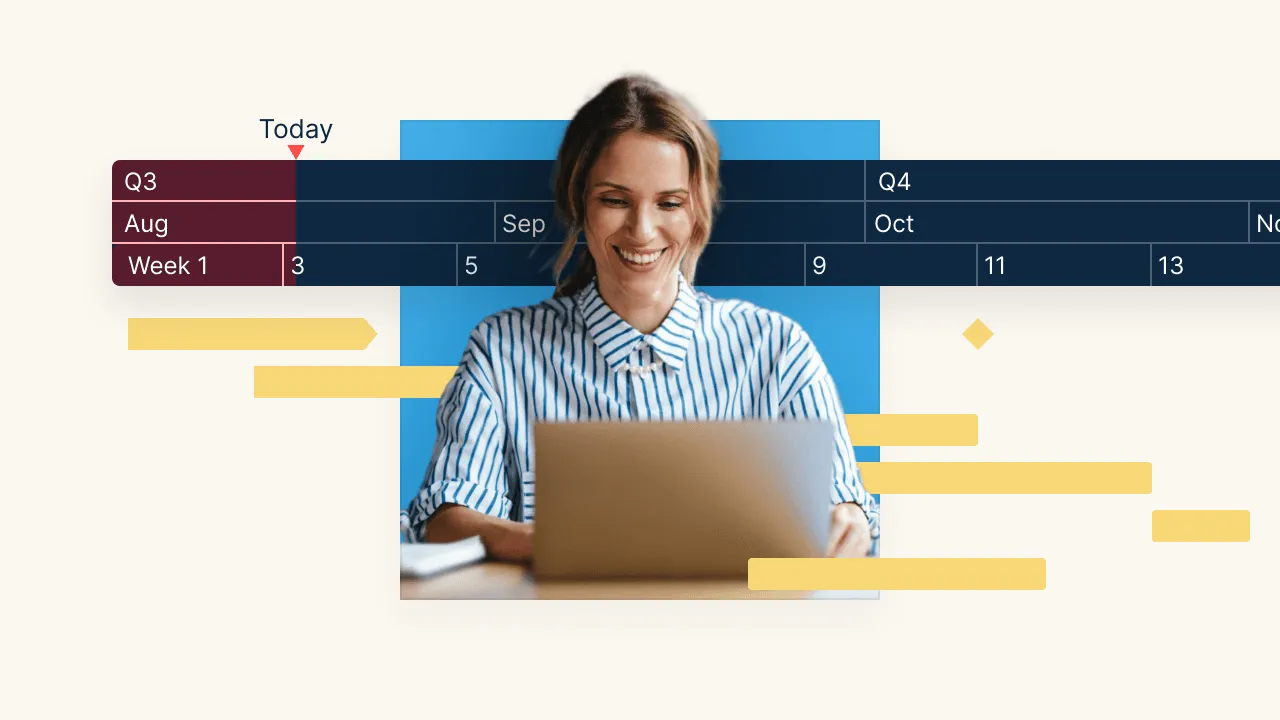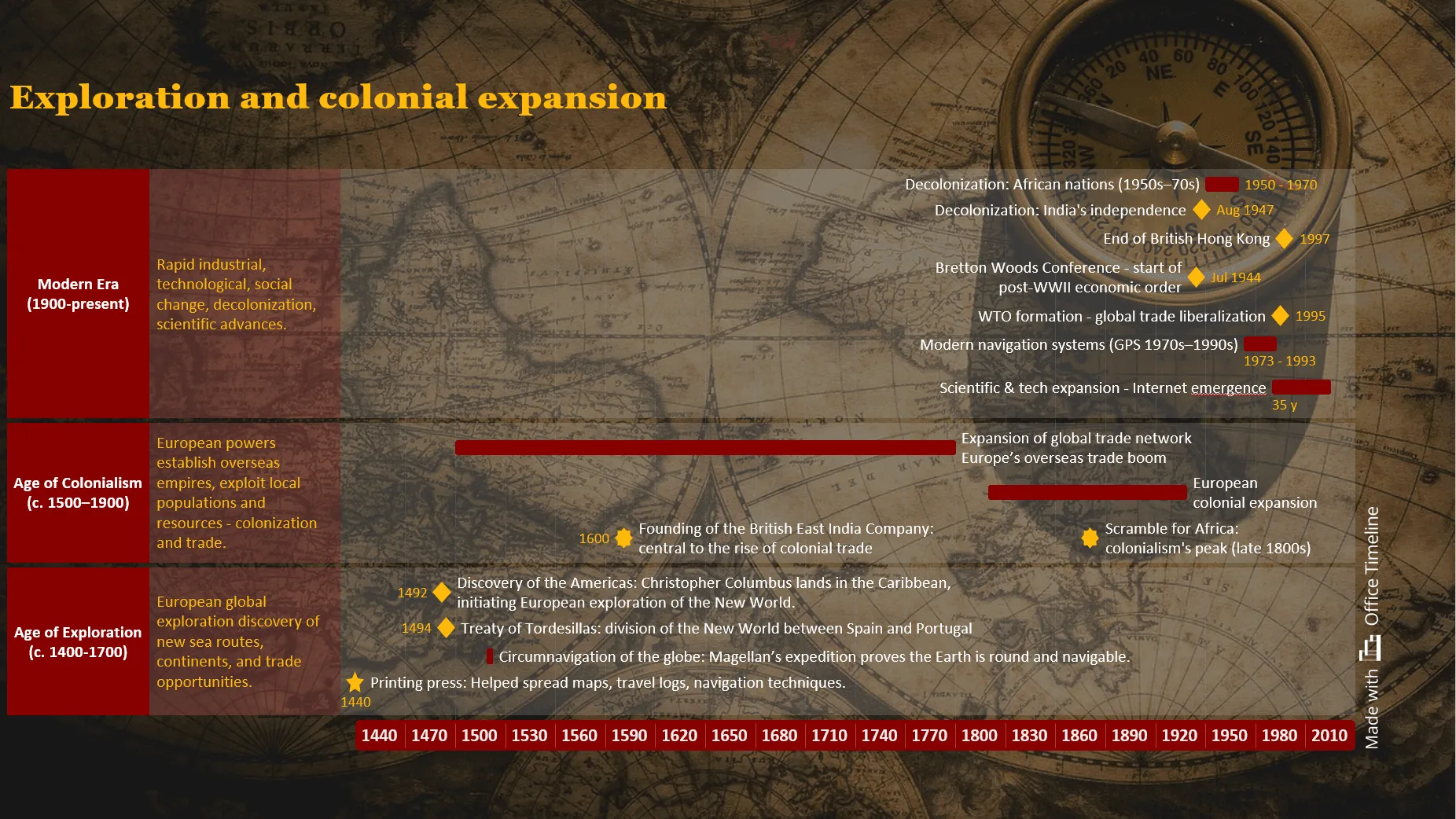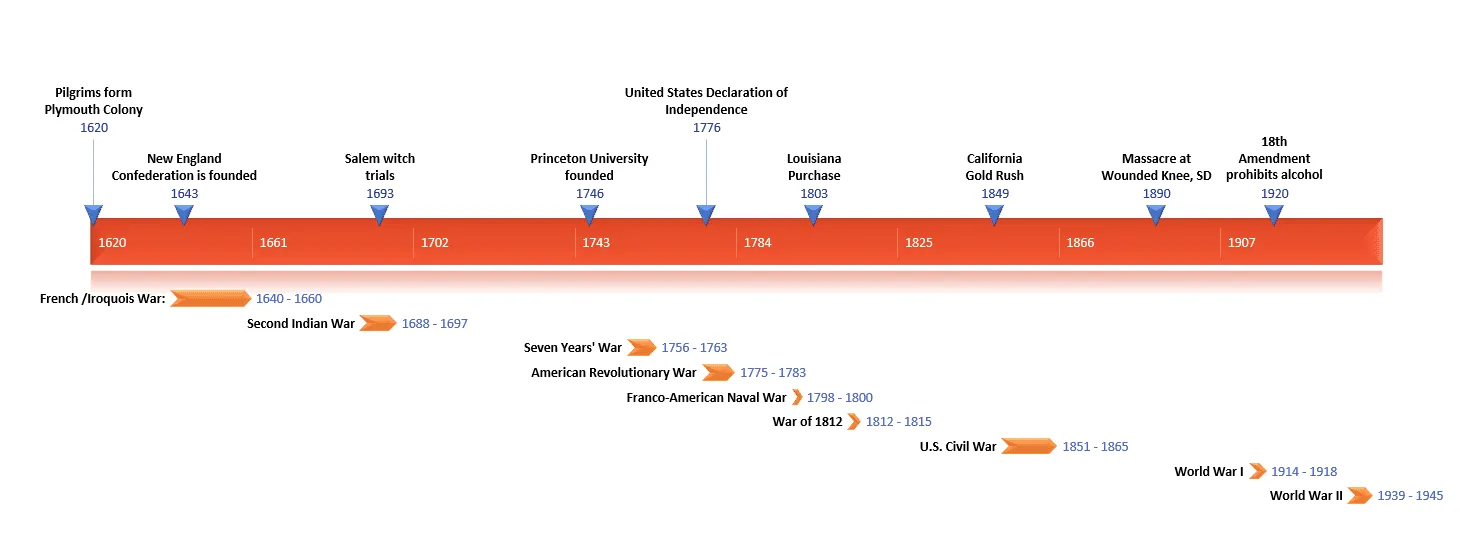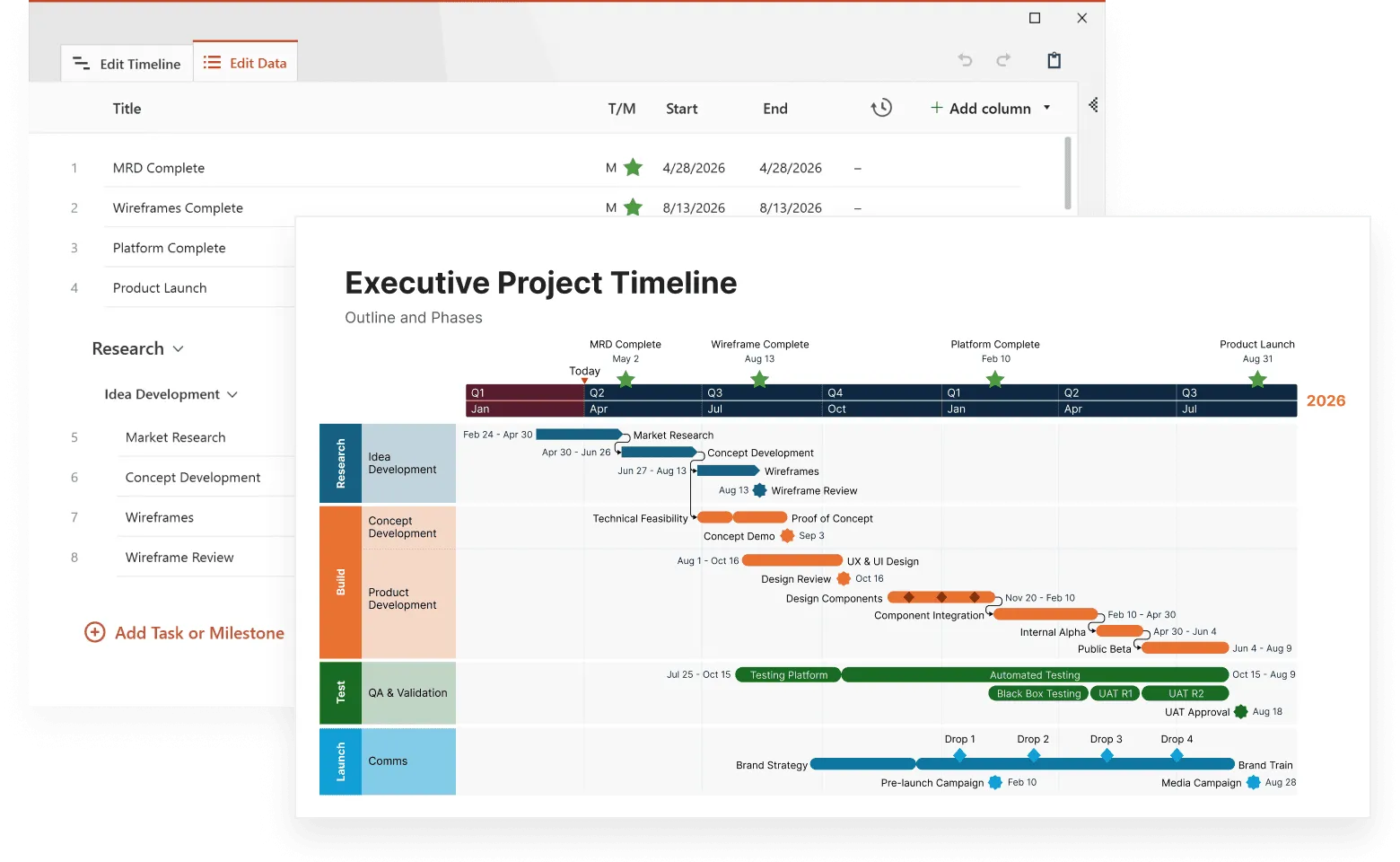Historical timelines organize events in chronological order, making complex history easier to comprehend. By arranging historical events linearly, we can better see connections between different periods and understand how past events influenced future developments.
This article examines what historical timelines are, their benefits, and how to create effective ones for research, education, or personal understanding.
Find out more about how timelines can simplify your world, from understanding history events to managing projects, and organizing personal goals, in our introduction to timelines.
Understanding history timelines
History can be compared to an enormous puzzle with countless pieces. Historical timelines provide structure to these pieces, organizing past events chronologically to improve understanding and analysis. By categorizing history into distinct time periods, these complex narratives become more approachable.
When we visualize the past through timelines, we see human civilization as a continuous story. Each historical era appears in sequence, from ancient history through the medieval period to modern times. This sequential representation helps us grasp not just dates but also causality between events. For example, seeing the progression from the Stone Age to the Indus Valley Civilization clarifies how early human societies evolved.
Timelines transform history from a blur of disconnected events into an ordered narrative that highlights the defining characteristics of each period. Breaking history into manageable segments allows us to understand human civilization as an interconnected story rather than isolated facts.
Historical time and chronology
Studying history extends beyond memorizing dates. Understanding context and significance makes history meaningful and applicable to present circumstances.
The distinction between historical time and chronological time adds depth to our understanding. Historical time focuses on significant events that substantially changed society, such as the development of writing systems or influential leadership periods. These transformative moments appear as central points on history timelines.
Chronology involves arranging events in temporal sequence, which is essential for analyzing cause-and-effect relationships. With clear chronology, historians can track the development of society, the rise and fall of empires, and technological advancement over time.
Examining the chronological sequence of historical periods, from classical era through medieval period to modern age, reveals how political systems, scientific thought, and cultural practices evolved.
Historical time periods
Historians divide history into specific time periods to better organize and study human development. Each of these divisions (Stone Age, Bronze Age, Iron Age, and later classical and medieval periods) represent different stages in social, cultural, and technological development.
When societies shifted from bronze to iron tools, this changed how people lived and worked. Iron tools and weapons lasted longer and could be made more widely available than bronze ones. Farmers could clear land more effectively, armies gained better equipment, and builders had stronger materials for their projects.
Major events often mark when one period ends and another begins. For example, when the Roman Empire fell in 476 CE, Europe entered the early Middle Ages. Political systems changed, trade networks shifted, and new forms of social organization developed.
The Renaissance period (14th-17th centuries) shows another important transition. During this time, people in Italian cities like Florence and Venice began studying ancient Greek and Roman texts again. Artists including Leonardo da Vinci and Michelangelo developed new techniques and explored different subjects in their work.
By studying these distinct time periods, historians can better understand how and why societies changed over time. The specific developments in technology, art, politics, and daily life tell us about the forces that shaped human history.
Timelines and the delineation of historical periods
These historical divisions don't exist in isolation—they form part of broader organizational systems historians use to make sense of the past. Timelines serve as practical tools that connect events across time, visualize change, and identify patterns throughout human history.
Historians use various methods to establish these chronological frameworks. Christian Thomsen's three-age system (Stone, Bronze, Iron) from the 1800s represents a technology-based approach. Other historians prefer political milestones, cultural shifts, or economic transformations as period markers. Western historical tradition typically employs Ancient, Medieval, and Modern categories, while Chinese historical scholarship organizes time through dynastic succession from Xia through Qing.
These chronological structures reflect cultural perspectives and priorities. European historical timelines emphasize events like Rome's collapse or the French Revolution as defining transitions. East Asian chronologies focus on dynastic changes as key turning points. African historical frameworks incorporate both indigenous developments and external factors such as trade networks and colonial impacts.
The lines between periods are rarely clear-cut. Historical change usually happens slowly, with elements of both old and new eras existing side by side. For example, late medieval practices continued well into what we call the Renaissance. These transition times can last for many decades or even centuries, and happen at different rates in different places.
Today's historians understand that strict time periods have limits. While helpful for organizing historical knowledge, these divisions can make complex historical processes seem too simple. Many scholars now view these periods as useful tools rather than fixed realities.
Timelines identify defining characteristics of each historical time period. By tracking progression from the archaic period through classical and medieval periods, timelines reveal distinctive traits and developments of each era. The classical era, for instance, is associated with flourishing arts, philosophy, and democracy in ancient Greece, while the medieval period features Catholic Church dominance and feudal systems. By breaking down history from prehistory to contemporary times, timelines help us understand civilizational evolution and the forces shaping different historical eras.
You can see below an example of visual timeline that illustrates the major historical transitions that shaped the world in the era of exploration and colonial expansion. It highlights key developments across three distinct periods, the Age of Exploration, the Age of Colonialism, and the Modern Era, showing how global trade, colonization, technological progress, and political control evolved over time.
This timeline was created using the Expert plan of the Office Timeline PowerPoint add-in, a professional timeline maker that you can try for free.
Practical applications of historical timelines
Timelines do more than just show when things happened. In classrooms, they help students grasp history by creating visual frameworks that improve understanding and memory. Teachers use timelines to show connections between events, build historical arguments, and compare different time periods, making history more accessible to students.
For professional historians, timelines are practical research tools. They organize historical evidence in ways that make it easier to analyze events that happened at the same time and identify meaningful patterns. History researchers often use timeline templates that they can adapt to specific projects, creating consistent and clear presentations of historical information.
Timelines as analytical tools
Historians use timelines to uncover cause-and-effect relationships in history. For instance, a timeline of the French Revolution shows how economic problems, political instability, and social inequality combined to trigger major historical changes. Seeing these factors arranged chronologically helps historians understand how multiple influences worked together to produce significant events.
Timelines also excel at comparative analysis. By placing different historical periods side by side, historians can spot recurring patterns throughout history, such as how empires rise and fall or how economic crises develop. Recognizing these patterns gives us better insight into what shapes human societies and offers practical lessons from the past.
The timeline below is a good example of how these tools support analysis. It shows major events in U.S. history from 1620 to 1945, including wars, political milestones, and social turning points. By laying out these developments together, it becomes easier to trace how early conflicts and decisions—like colonial wars or the Declaration of Independence—set the stage for later events such as the Civil War or the prohibition era. It also allows for comparison across time, showing how different types of conflict evolved and how periods of change were often closely linked. In this way, the timeline helps explain not just what happened, but how and why events unfolded the way they did.
This timeline was created using Office Timeline, a timeline maker designed for creating clear, visually engaging historical overviews that you can try for free. It offers an easy-to-use interface and professional templates, making it suitable for both academic and presentation use.
This timeline was created with the Office Timeline PowerPoint add-in, an easy-to-use professional timeline maker. You can try for free to design engaging historical overviews in minutes.
Types and formats of history timelines
Different timeline formats serve different purposes in historical analysis, education, and research, each offering ways to organize and interpret chronological information:
- Linear chronological timelines display events in time order, giving clear overviews of historical progression. These straightforward timelines work well for understanding the sequence of events within a single historical narrative. For example, a linear timeline showing the major battles of World War II helps readers grasp how the conflict evolved from 1939 to 1945.
- Comparative timelines show multiple streams of events simultaneously, highlighting connections between parallel developments. These timelines place two or more sequences side by side, revealing how different regions or aspects of society changed during the same period. A comparative timeline might show political developments in Europe alongside those in East Asia during the 1800s, illustrating how separate cultures responded to industrialization and imperialism during the same era.
- Thematic timelines group events by topics like political changes, cultural developments, or scientific advances, emphasizing specific aspects of history. Rather than attempting to cover all historical events, these timelines focus on particular themes. A scientific advancement timeline might track major discoveries and inventions across centuries, showing how knowledge built progressively over time.
Digital and interactive formats have grown increasingly popular, offering dynamic ways to explore historical narratives with multimedia elements like images, videos, and hyperlinks that enhance learning experiences.
Key components of historical timelines
A good historical timeline includes several important elements that makes it useful and engaging:
- Event selection criteria determine which historical moments to include. Not every event can appear on a timeline, so historians must choose the most meaningful developments. For example, a timeline of the American Civil War might highlight major battles, political decisions, and social changes while omitting minor skirmishes. Good selection criteria keep timelines focused and prevent information overload.
- Scale determines the timeline's time range and detail level. Broad-scale timelines might cover centuries or millennia, showing major historical shifts like the rise and fall of civilizations. Narrow-scale timelines might zoom in on specific periods, such as showing day-by-day developments during the Cuban Missile Crisis. The chosen scale directly affects what stories the timeline can tell.
- Orientation affects how people interact with the timeline. Vertical timelines flow from top to bottom, working well for digital formats where users can scroll through history. Horizontal timelines spread from left to right, fitting nicely on printed pages or wall displays. Each orientation creates a different viewing experience and suits different presentation needs.
- Symbols and markers highlight important events visually. Star shapes might mark decisive battles, while circles could represent political changes and squares might show cultural developments. These visual cues help viewers quickly spot different types of events and understand patterns across history.
Additional components include:
- Labels and descriptions provide necessary context about each event. Brief, clear explanations help readers understand why events matter and how they connect to the broader historical picture. Well-written labels transform a simple date list into a meaningful historical narrative.
- Visual elements like colors and icons help organize information. A timeline might use red for conflicts, blue for scientific discoveries, and green for cultural developments. These visual distinctions help readers identify patterns and relationships between different types of historical events.
- Consistent layout improves understanding and accessibility. When timeline elements appear in predictable places with consistent spacing and formatting, readers can focus on the content rather than figuring out how to read the timeline.
- Contextual information explains broader significance beyond individual events. Brief explanations of historical periods or themes help readers understand why certain patterns emerged and how events relate to larger historical processes.
When combined thoughtfully, these components transform disconnected historical facts into clear visual stories that help people understand how past events unfolded and connected to one another.
Creating your own history timeline
For students, educators, or history enthusiasts, a history timeline is a great tool to explore historical events and gain comprehensive understanding of the past. Here's a step-by-step process to help you build an effective historical timeline that communicates clearly and engages your audience:
Step 1: Planning your timeline
To create a well-structured timeline, start by planning your approach and content. This foundation ensures your final product will be both accurate and useful:
- Identify the key components you want to include.
- Select a specific time span to cover.
- Determine which significant events to feature.
- Organize events in chronological order.
- Consider adding media elements like images or maps.
Step 2: Selecting the time period
The time period you choose determines the scope and detail of your timeline. This decision shapes everything that follows:
- Choose whether to focus on specific events (like World War II).
- Or cover broader historical periods (like ancient civilizations).
- Set clear start and end points for your timeline.
Step 3: Identifying key events
Not all historical events belong on your timeline. This selection process requires careful consideration to create a meaningful historical narrative:
- Research which developments shaped the historical period.
- Consider political, social, cultural, and technological changes.
- Focus on events that connect to your timeline's main theme.
Step 4: Organizing events chronologically
With your events selected, you'll need to arrange them properly. This organization stage transforms a list into a true timeline:
- Place events in correct sequence to accurately reflect history.
- Use historical timeline templates for consistency.
- Create structured formats with placeholders for dates and descriptions.
- Include references to verify historical accuracy.
Step 5: Designing your timeline
The visual presentation of your timeline greatly affects how people understand and engage with it. These design elements transform raw information into an accessible historical story:
- Add visuals and descriptions to enhance clarity.
- Incorporate images, symbols, and color coding for visual appeal.
- Maintain consistent chronological spacing.
- Use visual markers to highlight particularly significant events.
- Balance information density with readability and engagement.
Historical timeline templates can simplify each of these steps by providing ready-made structures that ensure consistency and professional presentation.
Create polished history timelines
Try Office Timeline for free. Use simple templates to build accurate, visually appealing timelines for assignments, presentations, or lectures.
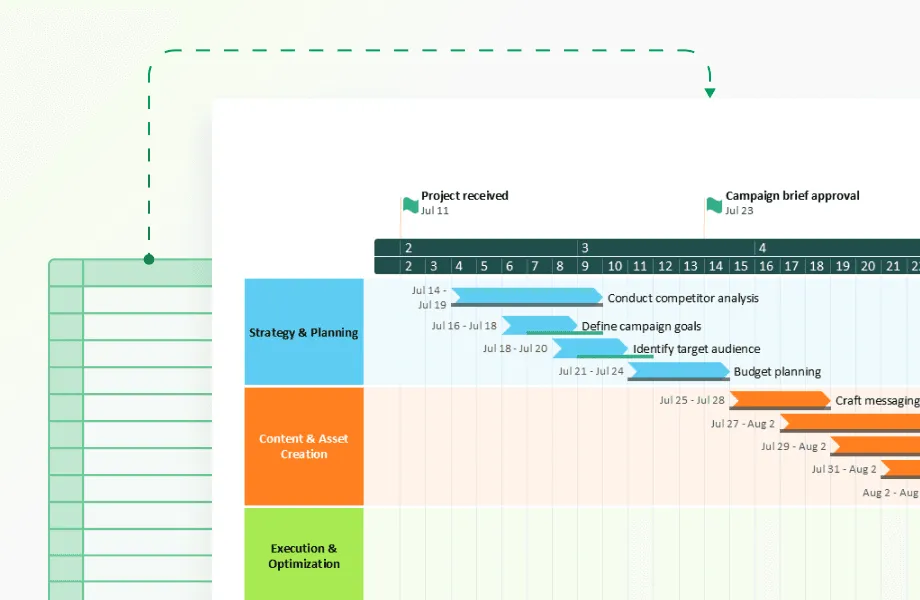
Challenges and considerations
While timelines effectively organize history, they present certain challenges. For example:
- Subjectivity and bias in timeline creation is one such challenge. Event selection and presentation reflect creator perspectives, which aren't always objective. Acknowledging potential bias and striving for balanced representation is important.
- Another limitation is simplification. Timelines condense complex historical processes into linear formats, sometimes resulting in oversimplified views of history where nuance and complexity are lost.
For comprehensive understanding, use timelines alongside other historical sources that provide additional context and depth. This ensures more complete understanding of historical events and their significance.
Conclusion: making sense of the past with timelines
Historical timelines bring clarity and coherence to historical study. They help visualize time's flow, understand relationships between events, and grasp human civilization's progression. This visual approach goes beyond just memorizing dates. It helps us understand cause and effect and appreciate how societies have evolved. By breaking down complex periods, timelines make learning history more accessible and less overwhelming.
Creating your own timelines can be particularly helpful. For students, it promotes active learning and a deeper understanding of historical connections as they research and organize events chronologically, improving memory and comprehension. For teachers, it serves as an engaging assessment tool and a visual aid to illustrate complex narratives and the sequence of events in the classroom. For historians, constructing timelines is often a key part of research, aiding in the organization of findings, the identification of patterns, and the detection of gaps in historical records.
The act of creating a timeline offers the opportunity to explore history more actively. It helps you understand events in context and see how they relate to each other, leading to a deeper understanding of what happened and why.
Frequently asked questions
As we wrap up, you may still have questions about how timelines reveal the story of history. This section answers the most common ones, explaining their purpose, benefits, and how they deepen our understanding of the past.
A history timeline provides visual representation of historical events, creating clearer understanding and analysis of human civilization's progression. This structured format helps recognize patterns and relationships across time.
Timelines organize historical events chronologically, clarifying context and significance of various periods. They highlight key developments and illustrate cause-and-effect relationships, deepening historical understanding.
Timelines support history education by developing student chronological frameworks, comparing historical periods, documenting work, and developing analytical arguments.
Create an effective historical timeline by selecting a specific time span, identifying key events, and establishing chronological order. Use templates for consistency and include visuals and descriptions to enhance clarity and engagement.
When creating timelines, be mindful of potential subjectivity and bias, and the limitations of simplification. Provide additional context to ensure comprehensive understanding of historical events.

